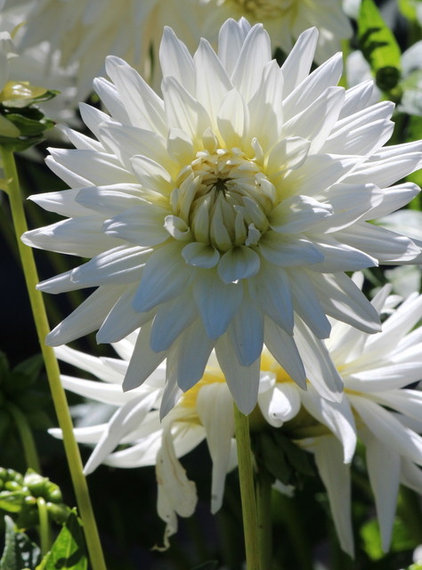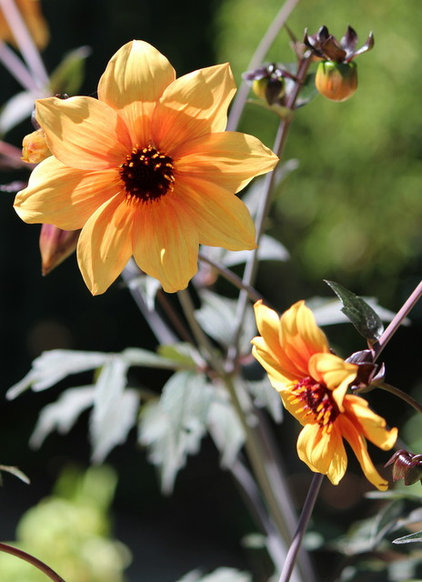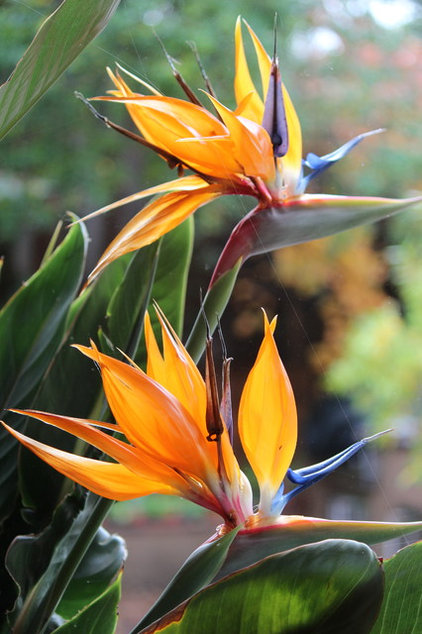To finish "the rest of the story," I went to the wedding but forgot what flowers the mother and daughter agreed to use.

The beauty of the Lily of the Nile. On my block, 13 of 20 homes have Agapanthus in their front yards. No wonder that some people are tired of it — maybe we'd get tired of Halle Berry too if she were in every movie we saw. But look closely at agapanthus. It's truly a beautiful perennial, with its sturdy clumps of foliage topped with big balls of blue blooms from early summer into fall really bring intrigue to your Gainesville landscape. Not to mention that partnering it with Orange Bulbine or Day Lillies brings out some team spirit in just before football season comes into play!
If you are tired by the traditional color or plant, look for a number of new varieties on the market; they're more compact, white or even darker blue. 'Baby Pete' is both compact and deep blue. 'Peter Pan' is compact as well.
Common name: Lily of the Nile
Botanical name: Agapanthus
USDA zones: 8 to 11
Water requirement: Moderate or more
Light requirement: Sun, or partial shade Mature size: 18 inches tall and wide, with flowers on stalks taller than 2 feet (depending on the type in your Gainesville, Florida Landscape)
Growing tips: Feed before growth starts in spring. Cut off faded flowers. Watch for snails and slugs lurking deep in the foliage.
 by Monrovia »
by Monrovia »
Don't judge junipers harshly. If you've experienced only the parsonia juniper — the king of overplanting a decade or two ago by builders (and some still yet today)— you've probably never yearned to see them in your landscape. The infamous parsonia grew to large to be a groundcover and looked ugly after a few years, regularly succumbing to disease. Haile Plantation Landscaping and other areas of Gaineville, FL have become overrun by the plant. But keep an open mind about the many good junipers now available. They have handsome forest-style looks, are easy to grow and are relatively pest free.
Shore juniper is just one favorite, and a newer form,Juniperus conferta 'Blue Pacific', is blue-green, hugs the ground and spreads well in dry places. 'Blue Star' juniper, shown, looks like a bonsai as it forms a mound; the bluish foliage particularly complements purplish or red plants. It makes a fine ground cover or accent plant, and looks great in a natural setting with rocks.
Common name: 'Blue Star' juniper
Botanical name: Juniperus squamata 'Blue Star'
USDA zones: 4 to 8
Water requirement: Light once established
Light requirement: Full sun
Mature size: 2 to 3 feet tall and 4 feet wide
Growing tips: Keep down weeds with mulch.

Remember dahlias. Few things say summer at Grandma's like a dahlia — it's up to you whether or not that's a good thing. There are thousands of types of dahlias, annuals and perennials, compact dwarfs and top-heavy giants that can grow in your Gainesville lawn. Flowers come in just about all colors except blue, in many different forms, from tiny ball shapes to floppy platters. Many of the plants sprawl, requiring staking and lots of care, and are tough to work into a landscape. As a general rule, mix dahlias (except for compact types) with other perennials and annuals, and keep them toward the back.
Dahlias have been developed over centuries, and many dedicated hobby growers and groups, such as The American Dahlia Society, can provide guidance.

Try the dark dahlias.Some of the newer dahlias fit better into today's gardens — particularly the types with dark foliage. They are more compact, with stronger stems that are ideal for cutting. Dark foliage lends a stylish mod look. 'Bishop of Llandaff' has almost black leaves and scarlet flowers. 'Mystic Spirit', shown, is a hybrid with purplish foliage and apricot-colored flowers.
Botanical name: Dahlia'Mystic Spirit'
USDA zones: 8 to 11; grown for summer only in colder climates
Water requirement:Moderate
Light requirement: Sun
Mature size: 2 to 3 feet
Growing tips: It's a great choice for containers, borders or mass plantings. Start with tubers or nursery plants in the spring after the last frost. Provide rich, well-drained soil. Deadhead faded blooms. .
 by Monrovia »
by Monrovia »
Meet the new generation. No wonder so many people got bored with Indian hawthorn (Rhaphiolepis, not a true hawthorn) in the past. It was the default plant for landscaping a ranch house — as a foundation plant or massed as a ground cover. There were tall and short varieties that had pretty flowers and were almost pest free. The fairly new dwarf yedda hawthorn rekindles our appreciation of Hawthorns — note that the Royal Horticultural Society gave it an Award of Garden Merit to plant in your Gainesville landscaping. It's a compact evergreen shrub with solid-looking, glossy leaves and white flowers in spring. And it's easy to grow, particularly in the Alachua County landscape. Use it as a medium-height background shrub, mass it as a tallish ground cover or line a walk or path. Yes, dwarf yedda hawthorn is also an outstanding foundation plant.
Common name: Dwarf yedda hawthorn
Botanical name: Rhaphiolepis umbellata 'Minor'
USDA zones: 7 to 11
Water requirement: Moderate
Light requirement: Partial shade to full sun
Mature size: 6 to 8 feet tall and wide, sometimes larger
Growing tips: Use Gainesville, FL irrigation regularly until the plant is established. Prune to control the shape and size after the spring bloom.

Turn your landscape into Paradise. Bird-of-paradise is a precious cut flower in many places — just look at the intricate, theatrical flower and its flamboyant range of colors to see why. But in much of Southern California and other mild climates, it grows like a like a weed. My antisnobbery suggestion: Even if you live where it's considered a weed (which in Gainesville it is not), plant at least one bird-of-paradise where you can see it up close — near a window or in a pot. Cut the flowers and bring them indoors — they're particularly welcome in midwinter, even at Christmas.
Common name: Bird-of-paradise
Botanical name:Strelitzia reginae
USDA zones: 9 to 11
Water requirement: Light to moderate; gets along with little water once established
Light requirement: Full sun, or partial shade in hot climates
Mature size: 5 to 6 feet tall and wide
Growing tips: In a borderline climate (which Gainesville is), plant it under an eave or in another spot that offers protection from frost. Water and feed it regularly for a lusher look.

Treat it nicely and see what happens. Here's another plant guilty by association with California freeway plantings, where it sprawls and climbs out of control — but also demonstrates how rugged it is. Give cape plumbago a little attention (sprinklers, feeding) and see how pretty it can become. The foliage is a nice bright green. And how can you resist those baby blues? In Hawaii the blue blooms are considered attractive enough to go into leis. This evergreen shrub grows big and fast, dependable as a background plant or on a slope. Or try it Hawaiian style — in a clipped hedge or even in a pot, where you can see the flowers up close from spring through fall. Wherever you plant it, make sure you hire a trusted Gainesville lawn maintenance professional to maintain it or it can grow out of control.
Common name: Cape plumbago
Botanical name: Plumbago auriculata
USDA zones: 9 to 11
Water requirement: Light
Light requirement: Full sun or light shade
Mature size: 6 feet and taller, and much wider
Growing tips: Prune or shear it back to control the size in late winter or early spring. by The New York Botanical Garden »
Take another look at coleus. Plant breeders have been churning out new varieties of coleus, another stalwart of industrial-size mass plantings. The newer varieties are taller and more sun tolerant, and display even more colorful leaves festooned in contrasting hot colors. Coleus is a perennial but is usually grown as a summer annual. It's a solid choice for those shady spots formerly filled by impatiens (now not recommended or being sold in many areas because of very destructive downy mildew). Coleus looks great mixed in beds or pots with other summer annuals, or plant single types alone for a mass effect.
New varieties come in a wide range of colors and shapes. Leaf colors include red, orange, yellow and pink; leaves may be tiny or huge, scalloped or frilly. Look for series such as Florida Sun, Solar and Sunlover. Or maybe you can't resist plants imaginatively named 'Pistachio Nightmare', 'Black Dragon' or 'Dipt in Wine'. The stunning variety shown here, with the pointillistic look, is 'Florida Gold'.
Common name: Coleus
Botanical name: Solenostemon scutellarioides
USDA zones: Hardy only in very mild climates; usually grown as a warm-season annual
Water requirement: Moderate or more
Light requirement: Partial or full shade. Varieties called "Sun Coleus" can take more light.
Mature size: 8 inches to 2 or 3 feet or taller and equally wide, depending on the variety
Growing tips: Be sure to water and fertilize regularly. Frequently pinch the stem tips of young plants for bushier growth. Cut off flowers (not much to look at) as you notice them. Watch for signs of distorted or discolored leaves, signs of a mildew scourge similar to what's wiping out impatiens.
